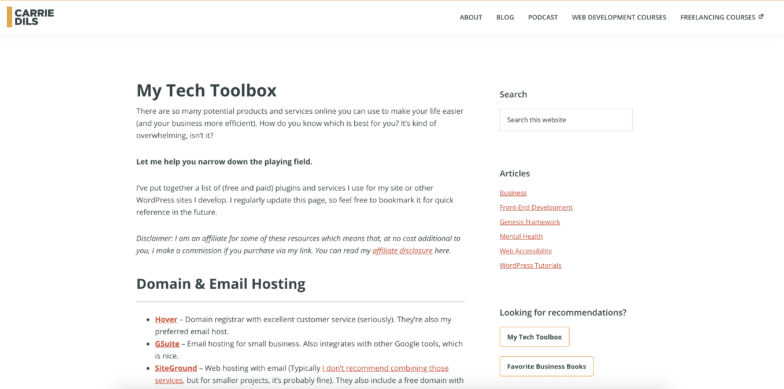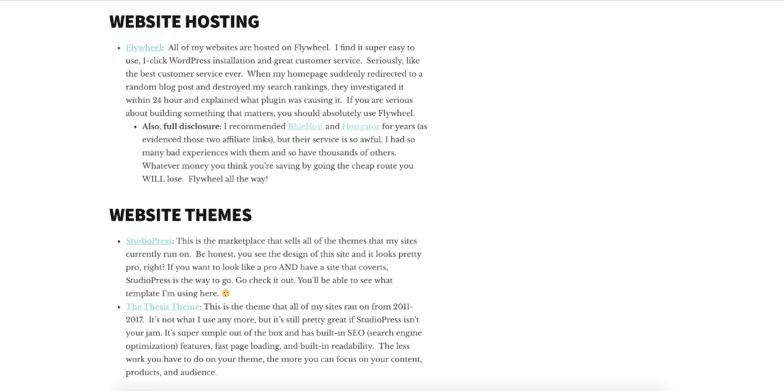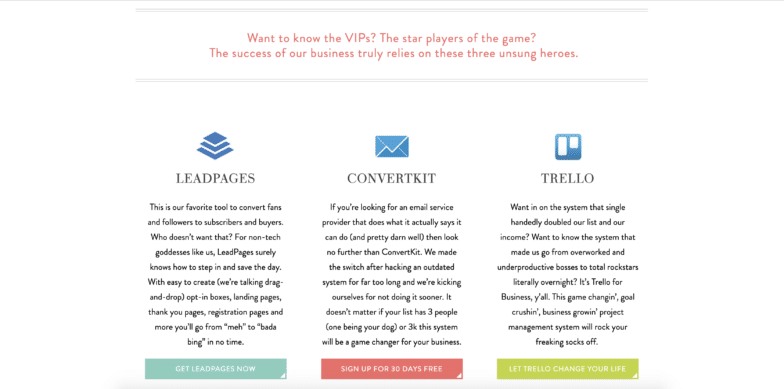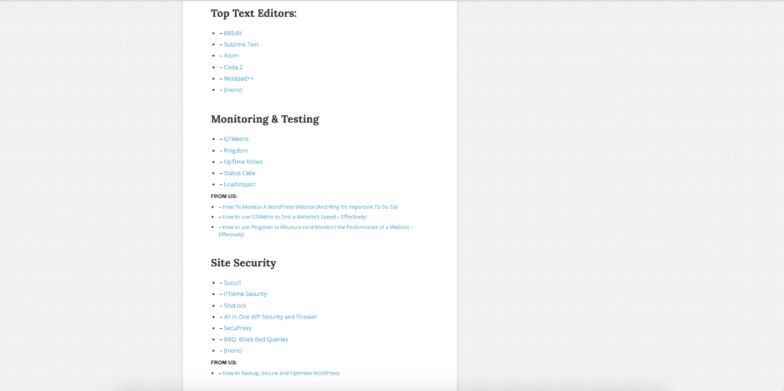
How to Create a Resources Page (and Earn Extra Money From It!)
A resource page is the best way to promote the services and products you use and love in your own business. If there’s a tool that’s helped you grow your business or streamline your workflow, it’s a great candidate to add to your resources page!
People create resource pages for a couple of reasons:
- They genuinely love the products or services mentioned and want to share their appreciation and gratitude with the world.
- They want to help their followers build their own business and recommend these services to help.
Your resource page can also help you make and maximize your affiliate income. The visitors on your site may or may not be looking for specific resources, but if they come across your page and find a product or service they like and sign up, that’s more money in your pocket!
But, I’m getting a little ahead of myself.
In this article, I’ll cover:
- What is a resource page
- How to create a resource page that earns referral commissions
- How to promote your page
Ready to create a super successful resource page to promote the products you’re an affiliate for? Let’s get started!
What is a Resource Page
A tools and resources page is a page on your website where you can list all of your recommended online tools, apps, services, and products in one place. It’s a one-stop shop your site visitors can easily access, navigate, and explore.

While you can link to anything you want in your resources page, it’s an especially great spot to put links to the brands you’re a referral partner for. Then if someone signs up based on your recommendation, you’ll earn a commission!
While normally called a resource page, it can also be called the affiliate page, recommended tools page, a toolbox page, a get started page, or something else that’s unique to your site.
How to Create a Resource Page
The process of creating a resource page may seem pretty straight-forward, but there are a few things you should keep in mind to ensure that it’s user-friendly, easy-to-navigate, and most importantly, persuasive!
Before getting started, it’s important to note that your resource page needs to include an affiliate disclosure or disclaimer, which states that you, as the referring party, will be getting paid if someone purchases something from your referral list. Here’s an example:
Disclaimer: I am an affiliate for some of these resources which means that, at no cost additional to you, I make a commission if you purchase via my link. You can read my affiliate disclosure here.
The affiliate disclosure listed on Carrie Dils’ page.
Let’s dive in to learning how to create an affiliate page!
5 key tips for creating a successful resources page:
- Only recommend products you trust
- Add personal descriptions
- Link to your related content
- Make it easy for users to navigate
- Double-check your links!
Only Recommend Products you Trust
The first step is deciding what you want to include on your resources page. Let’s say you want to recommend your hosting provider, a project management tool, a time tracker tool, and a few online courses. List any and all tools and do some research to make sure you’re in each of their referral programs, if they have one.
You should only mention the products you truly recommend. It’s easy to start signing up for competing referral programs, but you’ll be more successful if you can truly stand by your recommendation. And if someone has a good experience with one of your recommended products, they’ll be more likely to sign up for more!
Just because your favorite product or service doesn’t have a referral program doesn’t mean you shouldn’t still recommend them!
Add a Personal Description
While links are great, most people want to know a bit more about a product or service before clicking through to the site. By adding a description tailored to your audience, it can help persuade them to click the link and sign up.
Great things to include in a resource page description:
- What the company/product/service is
- Your personal experience
- How it can help your followers’ business or life
You know your audience better than anyone, so the content you add for the description should speak to them and make them feel like if they click on the link, their business (or life!) will be changed for the better. Be genuine in your description and use facts.
Some of the best resource pages I’ve ever seen have detailed, yet concise descriptions paired with them. Here are a few of my favorites!


Have some fun with your resources page. Boss Project certainly does!
Link to Your Related Content
Here’s a tip that few remember to include on their resources page: your own content! If you already have blog posts, guides, or other content that can further your recommendation for a product or service, add it! Just remember that the point is to entice a visitor to click through and purchase, so the entire page shouldn’t be a plug for your own content.
Content that can be added to your resource page:
- Blog posts
- Case studies
- Downloadable guides
Jorden from Writing Revolt does a great job promoting her own content!

Worried that you don’t have content to link to on your page? Time to add some! Not every single referral needs to be linked to a blog post, but your top recommendations should have some type of content tied in! Don’t forget to use your unique referral link in whatever new content you create.
Make it Easy for Users to Navigate
The fourth step is making your resource page easy for users to navigate, which includes organizing by category. Why? So users can quickly navigate to the sections where they may be wanting a recommendation.
Popular categories include:
- Getting started with WordPress
- Online courses
- Website hosting
- Website themes
- Business essentials
Another way to make it easy for users to navigate the page is including h1 and h2 tags. H1 and h2 tags are great for SEO, especially if they’re optimized with keywords. The more optimized your tags, the more likely you are to rank on Google and the higher you rank on Google, the easier it’ll be for a visitor to find click on your resource page in an organic search.
WinningWP has more than 10 categories of recommended tools. While they have a TON to navigate through, the categories make it easy to browse.

Double-Check Your Links
The most important part of creating a resources page is linking to the correct place. Certain referral programs will give you a unique referral link that you can share with your readers to sign up. This ensures that you’re getting credit for the referral if your readers make a purchase from that company.

The two biggest things to remember here are to make sure that:
1. Your links are correct and aren’t broken on your resources page.
2. They’re tagged or being tracked in one way or another, so you get the credit when someone signs up!
How to Promote Your Resources Page
Now that you have a user-friendly, easy-to-navigate, and persuasive recommendation page, it’s time to promote it!
Here are some of the best ways that you can promote your resources page:
- Link your page in the main menu of your site
- Add the link in the footer of your blog or website
- Link from other pieces of content to your resources page
- Create a PDF of your resources page for people to download for free
- Share it on your social channels
- Email it to your list
Basically, you want to make it as easy as possible for your friends, followers, and clients to find your resources page whenever they’re curious what tools you recommend!

Conclusion
With these tips, I have no doubt that you’re going to create a stellar resources page! Always remember to be genuine with the products you recommend, how you promote each of them, and how you let visitors know that you’re getting a commission if they sign up. Have other questions? Let us know in the comments!
Stay Educated With WP Engine
Would you like to learn more about WordPress, and the various ways you can use this platform to your company’s advantage? Subscribe to our newsletter and learn more about our managed WordPress hosting and our flexible hosting plans!












